“If that mockingbird won’t sing Papa’s going to buy you a diamond ring…” THE GEM PALACE INDULGES OUR PRIMAL FANTASIES
The Gem Palace in Jaipur, India is like a mythical setting for a James Bond heist. Uncut rubies cascade from cheesecloth bags, as if a dime a dozen. Sapphires, diamonds, emeralds – the size of golf balls – flood the show tables, begging to glisten on a body part. Antique rings open to reveal wells once filled with poison. Diamonds encrusted into glittering turtles form a clutch purse. Throngs of artisans hand-carve intricate Buddha heads, one after the other in exquisite exactitude, entirely from memory. A colossal man in white cotton dress, dripping with diamond buttons, sits Indian style on the floor surrounded by black suitcases brimming with jewels. “He’s like an enforcer,” says Siddharth Kasliwal the chic, charismatic, hot-pink handkerchief-wearing, twenty-eight year old scion of the Gem Palace, “Everyone in India knows who he is.” But unlike the gem sprawl of Madison Avenue, he seems to be the only security here. There are no uniformed guards making you uneasy as you peruse the merchandise. The atmosphere is warm and friendly, filled with tea, enchantment…. and millions of dollars worth of jewels.
And so it goes at the Gem Palace, nestled in a dusty street in Rajasthan’s Pink City, a place founded by the fierce Rajput warrior clan, where artisans with centuries’ old secrets still live in a Medieval blueprint that snakes around a 17th century wonder known as the Amber Fort. If you’re lucky enough to get here and meet Siddharth, you can be a princess for a transporting couple of hours, as he drapes you in over 870 carats of diamonds and 5500 carats of pearls. Later, when you catch up with him at the Jaipur landmark, the Rambagh Palace, for a drink, it may have to be quick…the Saudi Royal family is, after all, buying stones in the adjoining dining room.
It’s pure fantasia for most, but for Siddharth, it’s just another day. His family is synonymous with India’s gem trade. Serving as the official jewelers to the Maharajas, Rajasthan’s royal family, the Kasliwals have been in the business for over two hundred years. Today, they are undeniably global, with stockists like Barney’s New York, and exhibitions at the Metropolitan Museum of Art, and Somerset House London. When you enter “gem” into Google, the Gem Palace is the second search item, trailing only behind “gem definition.”
But for the Kasliwals, jewelry is a lot more than business. It’s history, tradition, art, expression, and passion… a way of life, bordering on a spiritual worldview. You won’t leave the Gem Palace without learning a thing or two about the human existence. At one point in our meeting, Siddharth showed me a series of pieces in which seven figure stones are worn facing the body. “They’re concealed,” he explained, “so only the wearer knows of their presence, [because] it’s not only what eyes can see. It’s the body and soul also, that sees and feels.”
Siddharth has recently taken the reins of the Gem Place, in the wake of his father’s, the legendary Munnu Kasliwal, untimely passing. I chatted with him a short time ago as he prepares for the release of the upcoming book on his father, a prestigious exhibition at the Kremlin in Moscow, and his new eponymous line of more affordable wares. It’s a wonder he had any time to talk, but his unique hybrid of energy and duty, gave way to a fireside interview at midnight… Jaipur time.
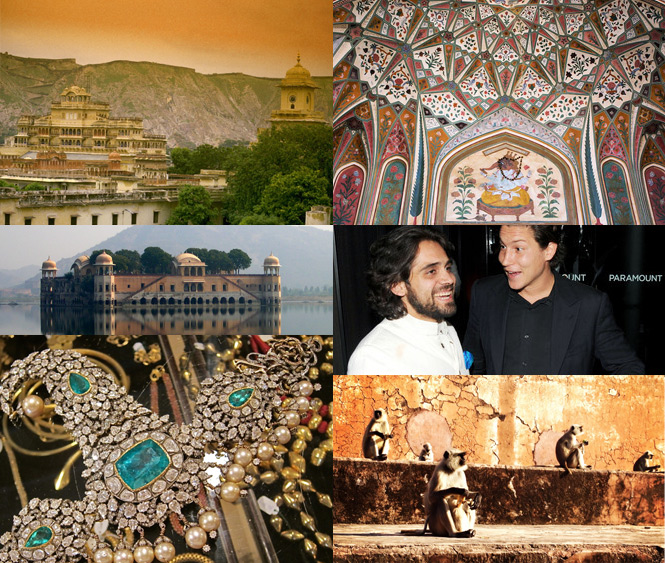
EMILY JEROME: Could you tell us briefly about your family’s history in the gem business? And a bit of history regarding the gem business in Jaipur?
SIDDHARTH KASLIWAL: Gem Palace has been in the jewelry business for over 200 years…The company was established under the English rule in 1852…running with the Kasliwal family for many generations. I am currently running the business with my uncles, Sudhir and Sanjay and cousin, Samir.
EMILY JEROME: Your father modernized Indian jewelry — really making it famous among western audiences — what are the crucial design elements he altered in order to achieve this crossover fame?
SIDDHARTH KASLIWAL: My father, the late Mr. Munnu Kasliwal, modernized Indian jewelry with his unique and timeless designs. [He was] the first Indian jeweler to exhibit at the Metropolitan Museum of Art in New York and at Somerset House in London. He was the first person to conceptualize traditional Mughal Indian designs with semi-precious stones, in which each and every stone is specially cut and calibrated to its specific design. He also started the Indo-Russian collection which [uses] finely cut rose-cut diamonds in an alloy of gold and silver… An old technique primarily used in Russian Imperial jewels and Victorian era jewelry… And currently one of the best sellers at Barney’s, New York.
EMILY JEROME: You are now running the business. How has that experience been for you so far? What are your greatest challenges? What do you see for the future?
SIDDHARTH KASLIWAL: I have been actively involved in the business for the last nine years since age nineteen. I have been working and learning from my father in all fields of the business, right from manufacturing, [to] production and design. The greatest challenge is to keep up the name and legacy… I realize I have huge shoes to fill. What I see for the future is to keep the fine craftsmanship alive and create traditional yet timeless designs… To have a Munnu website dedicated to his designs and his life, and his role in the jewelry world. Also, The Gem Palace exhibit in 2014 at Kremlin, Moscow.
EMILY JEROME: Could you tell us a little bit about how you hire your artisans? Where they come from etc.?
SIDDHARTH KASLIWAL: All our artisans are generation-to-generation craftsmen. Their forefathers worked for Gem Palace and they are currently working for us… A common trade practice in India. They are all mostly from Jaipur or migrated from nearby cities since Jaipur remains the city of arts and excellence.
EMILY JEROME: At the Gem Palace, I saw your pieces all being cut by hand. What seemed most remarkable was that your artisans could carve seemingly the exact same thing, over and over, totally from memory. How do they do that?
SIDDHARTH KASLIWAL: All our jewelry is handcrafted as it is the old traditional way and keeps the character. We are very lucky to have excellent carvers and with constant training and practice they keep this skill alive. I guess it runs in their blood.
EMILY JEROME: Tell us about your own line?
SIDDHARTH KASLIWAL: My current line is [in a] more fun and affordable range. From little elephant, turtle, [and] frog charms, to colored stones set in gold strung on a simple chord. Something in which my friends and people my age can easily buy without a hole in their wallet. I am also continuing my father’s Mughal contemporary jewelry line… adding more and new designs in that line… [like] some tassel necklaces and earrings.
EMILY JEROME: What are your favorite stones and why?
SIDDHARTH KASLIWAL: My favorite stones are aquamarine and spinel. I would say spinel particularly as I have always been intrigued by it since a very young age for its amazing luster and various colors. It was also my father’s favorite stone since it’s [a] very mysterious stone, very few people know about it. For the longest time, this stone was confused as rubies [because of] the unique red color. My father had been collecting egg-sized spinels for the last 25 years when they were worth nothing. Now they cost a fortune.
EMILY JEROME: What is your favorite piece of jewelry at the moment and why?
SIDDHARTH KASLIWAL: It’s difficult to point out one single piece as I love most of my father’s pieces, but I would say a 271 carat spinel, set with an 8 carat Golconda diamond, strung on a simple black chord. What I love about it is how such important stones are just strung on a simple black chord instead of on an expensive diamond line. Also not to forget! His naughty turtle diamond ring that reveals a Kama sutra portrait under the turtle’s back…it always amuses me.
EMILY JEROME: Lastly… could you tell me a little bit about the pieces I tried on at the Gem Palace: the diamond wedding headpiece, the diamond turtle clutch, the large diamond turtle ring which opens, the pearl and diamond harness, the diamond snake bracelet…?
SIDDHARTH KASLIWAL: The diamond wedding headdress and necklace was made for a private family for a royal wedding. Unfortunately, I can’t reveal the name, as most of our client list is confidential. It took us 4 years to complete and it is made up of 870 carats of fine diamonds and over 5500 carats of pearls. The turtle clutch bag was made out of my father’s pure madness and love for turtles. It took us over 2 years to collect the diamonds and it consists of over 50,000 pieces of diamonds crusted even inside and on the sides with a diamond link chain to make it into a bag from a clutch. The turtle ring shows my father’s humor and his playfulness with jewelry. Also, it highly amused all his friends and clients and is a good conversation piece. The diamond and emerald vest was just again made more as a challenge and a unique design. It’s a wearable piece of jewelry despite its scale and size. The diamond snake bracelet was made, as my father particularly loved the movement of a snake’s body… Also because of [the] historical significance of snakes in jewelry since Egyptian times. The snake is set with the diamonds underneath so no one knows but the wearer. As I mentioned, it’s that same concept that it’s not only what eyes can see…
Photo Credits: (Left, top to bottom) capitolcharlotte.com, tourandtravelsjaipur.com, thebaghagdiaries.com (Right, top to bottom) picture of amber fort is from normankoren.com, siddarth picture, bfanyc.com
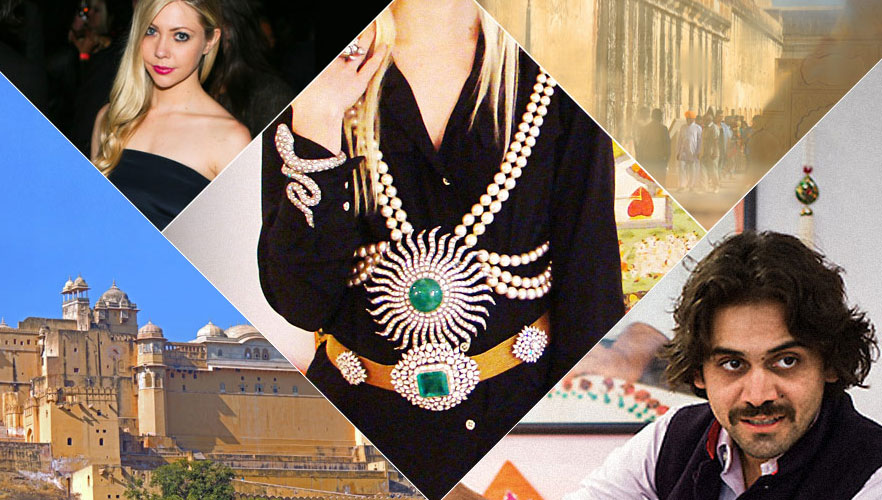
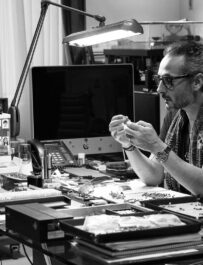
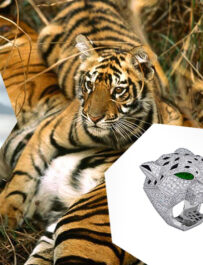
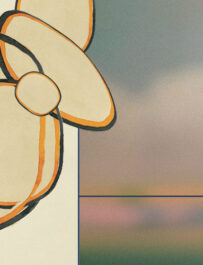
Comment
I’m very happy to uncover this web site. I want to to thank you for your time due
to this fantastic read!! I definitely savored every part of it and i also have
you book marked to check out new stuff on your site.